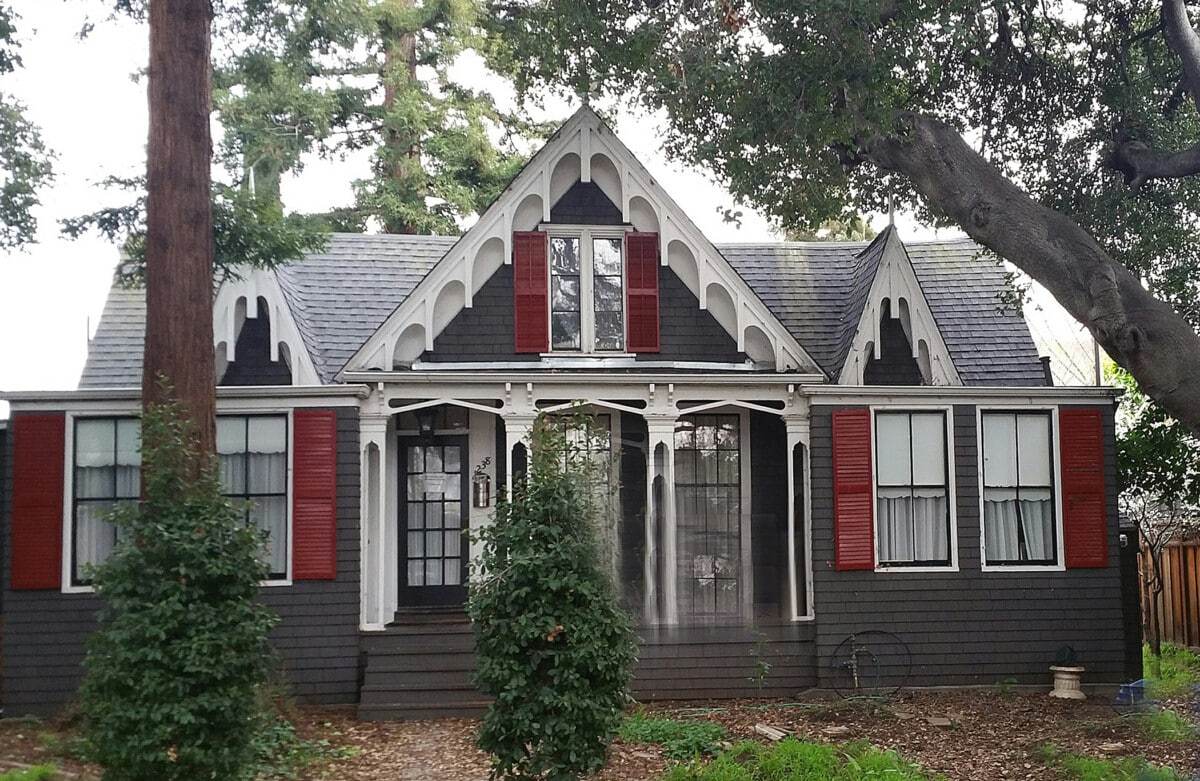See early prefab houses and other historic East End architecture on this Saturday’s walking tour.
Many people automatically associate prefabricated houses—prefabs—with a Sears catalog. During a recent Alameda Post walking tour, a homeowner stopped the group to assure us that his home was not one of the prefab houses from the pages of the aforementioned catalog.

Prefab houses predate Sears. We will see one built from a kit in 1854 first-hand on this Saturday’s tour. John Nelson Webster arrived in California aboard the barkentine Henry Harbeck on Sept. 17, 1849. He liked Alameda’s peninsular environs so much that sailed home and convinced his wife, Caroline, to return to California with him. In 1854, the couple boarded the very same ship and set sail with a prefabricated home tucked aboard.
John and Caroline had the home floated across San Francisco Bay and assembled it at a spot just outside the brand-new town of Alameda. The idea of setting up a prefab home likely came from what John had already seen and experienced in San Francisco as a ’49er. “The building trades were technologically prepared to produce ready-made houses when news of the gold strike came through late in 1848,” Charles Peterson relates in “Prefabs in Gold Rush California,” which he wrote for the Journal for the Society of Architectural Historians [PDF].
East End Architecture
Saturday, August 27 — Part III
Join Dennis Evanosky to explore the neighborhood at the southeast end of the island that was once the original little town of Alameda. Meet at Encinal and College avenues. Tickets are $15 in advance, $20 at the tour.More Tour Info ›
Peterson related that one of the first California handbooks, Sherwood’s Emigrant’s Guide, dated Feb. 12, 1849, and published in New York, carried advertisements for two dealers in houses. The writer theorized about organizing companies of Gold Country adventurers and proposed that brick and other materials instead of the usual ballast be carried for later sale and that “the joiner work of a house” be done on board to relieve the monotony of the long voyage. Peterson writes that by the time the time Sherwood had published its guide, “the Boston and California Joint Stock Mining and Trading Company had already set sail with two prefabricated houses aboard.”
Ralph Waldo Emerson noted in his diary that “an army of a hundred thousand men (were) embarking for California with ‘tools, instruments, books and framed houses.’” Peterson tells us that “many of these frames were already stocked in waterfront lumber yards but production was to be tremendously stepped up all over the world. New York City was one of the greatest centers of this booming industry.” He says that an estimated 5,000 houses had been sent out or were under contract in New York by the fall of 1849.
Peterson relates the story of Franklin A. Buck, who had embarked from New York to California aboard the brigantine George Emery with four frame-houses on deck. (Buck) rounded the Horn to land in San Francisco on Aug. 6, 1849, and test his luck. “The first (gold) dust that I received, $2,800, on our selling two houses,” wrote Buck, “…made my eyes sparkle and my heart beat rather quickly as I spooned (the gold dust) out into a two quart pail.”
Not a bad profit on a purchase of less than $300!
John and Caroline were not the only residents to build a prefab home in Alameda. Even the founders of the new town, William Worthington Chipman and Gideon Aughinbaugh lived in houses they had floated across San Francisco Bay. The dream of turning the new town into the county seat did not last. Alameda lost the vote to San Leandro. There would be neither a courthouse on Court Street nor an accompanying fountain one street over. Squatters stole Chipman and Aughinbaugh’s land. The state of California and federal government put an end to the idea of a railroad to Stockton. The wettest winter on record in December 1861 and January 1862 brought on the Great Flood of 1862, dashing the hopes of the farmers here. The Civil War beckoned families to return east.
Finally in 1864, A. A. Cohen’s San Francisco & Alameda Railroad bypassed the town that bore its name. The town of Alameda withered as families moved not only their homes, but even their places of worship further west to align with the railroad and, in 1872, with the horse-car lines. The coming of the South Pacific Coast Railroad in 1878 and the electric streetcars in 1893 brought today’s East End new life.
At last, in the Roaring ’20s, the East End sprang to life once again. Homes were built in the latest styles: Storybook, Craftsmen and Prairie. Bungalow sprung up everywhere. All these stand alongside the beautiful Victorian-era homes that remain with us today. These include John Nelson and Carolyn Webster’s home, that prefab house from so long ago.
Join me and the Alameda Post this Saturday, August 27 for a walking tour of the area at the East End of the island that once made up the little town of Alameda. We will meet at the intersection of Encinal and College avenues at 10 a.m. Advance tickets are $15. More information is available on our History Walking Tours page.
Dennis Evanosky is the award-winning Historian of the Alameda Post. Reach him at [email protected]. His writing is collected at AlamedaPost.com/Dennis-Evanosky.



